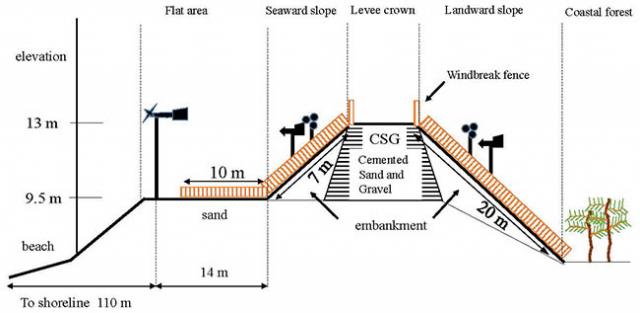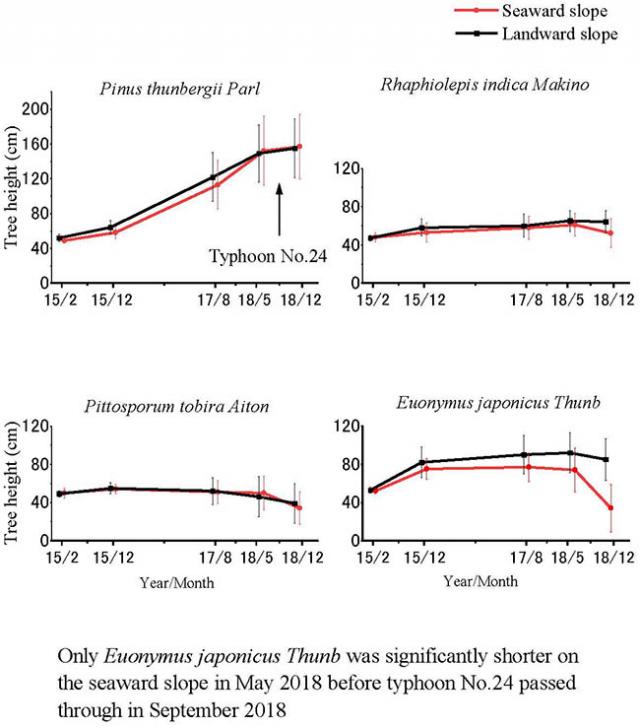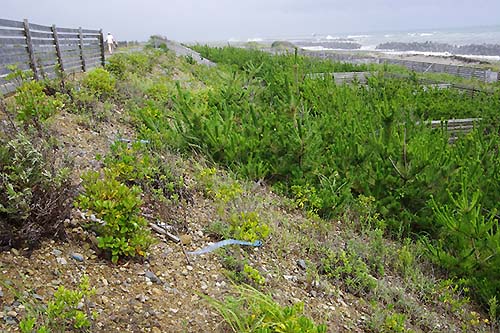Home > Research > Research Results > Research Results 2020 > The growth of trees planted on tide embankments differs greatly depending on the tree species and wind conditions
Update:November 18, 2020
Main content starts here.
The growth of trees planted on tide embankments differs greatly depending on the tree species and wind conditions
| Article title |
Evaluation of tree growth and wind conditions on tide embankments in Hamamatsu City, Shizuoka Prefecture |
|---|---|
| Author (affiliation) |
Hiroaki Hagino (a), Kei Enda (b) (a) Tohoku Research Center, FFPRI. Morioka, Iwate, Japan. (b) Shizuoka Prefectural Research Institute Agricultural and Forestry, Forest and Products Research Center, Hamamatsu, Shizuoka, Japan. |
| Publication Journal |
Journal of the Japanese Society of Coastal Forest, 19 (1), 3-9 (2020) |
| Content introduction |
To prepare for a tsunami that might occur in conjunction with a massive Nankai Trough earthquake, tide embankments are being constructed along the Enshu Coast in Shizuoka Prefecture and their slopes are now being planted with trees. Before that, huge embankments had already been constructed in locations that had been subjected to strong tidal winds, but there are no examples of them being planted with trees, and various issues must be resolved. One important issue is the selection of tree species. Therefore, this study was conducted to examine the effects that wind has had on the growth of trees planted on a tide embankment in Hamamatsu City (Fig. 1). In the present study, 4 tree species were selected for planting: Pinus thunbergii Parl, and 3 broadleaved species that are resistant to pine wilt disease: Rhaphiolepis indica Makino, Pittosporum tobira Aiton and Euonymus japonicus Thunb. The vertical growth of these species that were planted on the tide embankment was observed on both the landward and seaward slopes, as were the wind direction and speed on the slopes. As a result, it was found that the average wind speed on the seaward slope was 1.5m/s, and 0.9m/s on the landward slope, thus winds on the seaward slope tended to be stronger. The planted trees of P. thunbergii grew well on both slopes, while the 3 broadleaved species did not grow well (Fig. 2). The reason for the generally poor growth of the broadleaved species may have been due to conditions other than the wind. Up until May 2018, there was almost no growth of R. indica and P. tobira on either slope, and no differences in growth rate due to differences in wind conditions were observed. However, compared with these species, the other broadleaved species, E. japonicus, tended to show somewhat tall growth on the landward slope, and it can be surmised that environments where tidal winds were gentle had an effect on this growth. Additionally, in a study conducted in September 2018 after the passage of the record-breaking Typhoon No. 24, tree height of all 3 broadleaved species decreased on both slopes, which was especially noticeable on the seaward slope. While the typhoon was passing through the area, the maximum wind speed on the seaward slope (25.2m/s) was more than twice as high as that on the landward slope (10.8m/s), and it appears that such a difference in wind speeds led to tidal wind damage (mortality) of planted trees. From these results, various measures should be considered when planting broadleaved trees on tide embankments, such as establishing dense windbreak fences on seaward slopes, and promoting the growth of P. thunbergii on front lines to better utilize their windbreak effects (Photo).
Wind speed and wind direction were observed from 6 November 2017 to 30 September 2018.
Figure2 Vertical growth of planted trees (Vertical lines show the standard deviation).
Photo Broadleaved trees and P. thunbergii on a seaward slope |
Copyright © Forest Research and Management Organization. All rights reserved.



